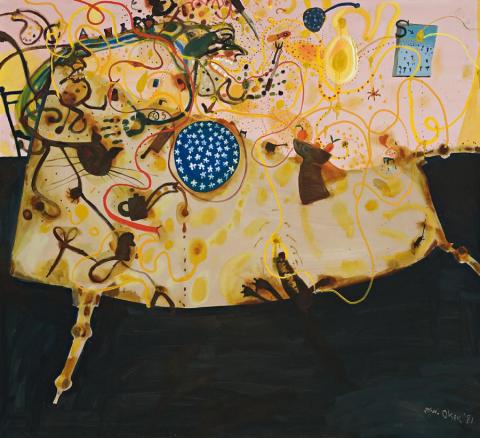DUCK A L'ORANGE, 1981
John Olsen
oil on canvas
167.0 x 182.0 cm
signed and dated lower right: John Olsen ‘81
Bortignon's Kalamunda Gallery of Man, Perth
Christensen Fund Collection, Perth
Deutscher Fine Art, Melbourne
Deutsche Bank, Melbourne
John Olsen 81-82 and Noela Hjorth, Bortignon's Kalamunda Gallery of Man, Festival of Perth, 1982, cat. 32 (illus. cover exhibition catalogue) On loan to the Art Gallery of Western Australia, Perth from 1982 (label attached verso)
John Olsen Retrospective, National Gallery of Victoria, 1 November 1991 – 2 February 1992 (label attached verso)
Hart, D., John Olsen, Craftsman House, Sydney, 1991, p. 162, pl. 107 (illus.)
Duck à l'Orange 1981 belongs to that creatively fertile period John Olsen spent in the village of Clarendon, near Adelaide in South Australia. He affectionately called the place 'Aix-en-Clarendon'.1 South Australia was still in its sybaritic days of pleasure and enlightenment; and Olsen's paradise embraced the beauty of the undulating hills and beaches of the southern vales, views splendid, of the vineyards of McLaren Vale, and Maslin Beach. Here he recreated 'his dream of a Mediterranean way of life', food being a natural part of his life style.2 Like the fertile countryside from which much of it came, it was also the subject of his paintings. Golden Summer, Clarendon, 1983, in the collection of the Art Gallery of New South Wales captured something of the poetry of the place; and A Road to Clarendon: Autumn, 1985, won the Wynne Prize. In Broken Egg and Summer Landscape, 1986-7, he combined his love of both, the egg ever his personal metaphor for life and fecundity.
Gregarious and a bon viveur, it is natural to find themes of food and cooking throughout Olsen's art. His two 1966 versions of Portuguese Kitchen and the Dunmoochin Love in the Kitchen 1969 are among his best early works. Deborah Hart, in her monograph on Olsen, found interesting parallels between the 'cumulative nature of the paella' and 'Olsen's attitude to life and art.'
I have painted pictures of paella which I cooked on a iron huge pot 'It is the colour of the Spanish flag, the rice is saffron laced with orangy red peppers, chicken, fish, mussels, port, tomatoes and parsley. It is a sharing, gregarious, sumptuous dish.'3
In this work, as in others, images of food socialise with kitchen implements, glasses of red wine, the chef doing all things at once with the greatest élan, and a large fish on a dish. In Duck à l'Orange, 1981, Olsen returns as the mighty magician of kitchen and studio, conjuring up the colours of food for the table. From the picture left, a profiled figure emerges from the calligraphy to face the golden duck. Carving knife and fork are raised, and the bared teeth of man and dog below speak of the feasting frenzy to come. Various dishes, cooking implements and objects sport across the festive table in sensuous, manic delight as the eye enjoys a view both elevated and in profile.
Duck à l'Orange, 1981, was acquired by the Christensen Fund Collection at the time it sponsored the major expedition to North-West Australia and the Kimberley culminating in The Land Beyond Time publication. The important group of powerful landscape paintings produced by Olsen over the fifteen month period that followed was loaned by the Christensen Fund, along with Duck à l'Orange, to the Art Gallery of Western Australia. This entire group of works was also made available for touring to state and regional galleries and the paintings are now amongst Olsen's best known and most highly regarded.
1. Hart, op. cit, p. 161
2. ibid.
3. ibid., p. 75
DAVID THOMAS
